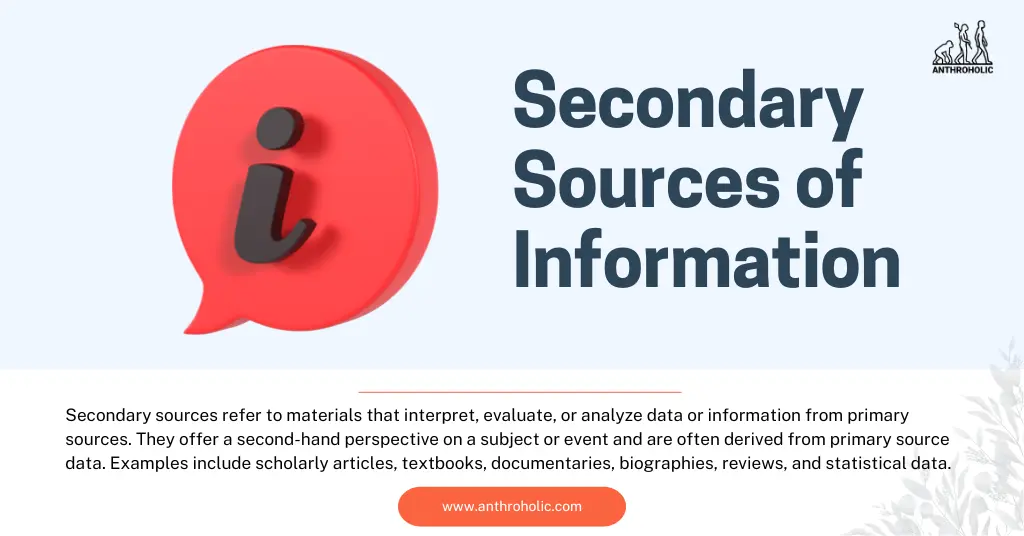AI Answer Evaluation Platform Live Now. Try Free Answer Evaluation Now
Secondary sources of Information
Collecting data is critical to any research process. It provides the necessary information that forms the basis for analysis and decision-making. Primary and secondary sources form the core data collection methods in research. While primary sources offer firsthand, raw information, secondary sources provide interpreted, analyzed, or processed data.

Understanding Secondary Sources
Secondary sources refer to materials that interpret, evaluate, or analyze data or information from primary sources. They offer a second-hand perspective on a subject or event and are often derived from primary source data. Examples include scholarly articles, textbooks, documentaries, biographies, reviews, and statistical data.
Table 1: Examples of Secondary Sources
| Type | Examples |
|---|---|
| Academic Publications | Journal articles, Research papers |
| Media Content | Documentaries, News articles |
| Books | Textbooks, Biographies |
| Official Data | Census data, Business reports |
| Internet | Websites, Blogs |
Types of Secondary Data Sources
There are several types of secondary sources used in research, grouped based on their characteristics and applications:
Published Sources
Published sources are perhaps the most popular types of secondary sources used by researchers. They include:
- Scholarly or academic journals: These are usually peer-reviewed publications with research findings on various subjects.
- Books and textbooks: Provide detailed analysis and interpretations on a subject matter.
- Newspapers and magazines: Offer a journalistic viewpoint on events and topics.
Unpublished Sources
Unpublished sources, as the name suggests, refer to those sources not made publicly available. They may include:
- Personal letters: Although they may seem primary, when used to study a topic from a different perspective, they become secondary.
- Internal business reports: They offer insights into the organization’s functioning and market scenario, among other aspects.
Electronic Sources
In the digital age, electronic sources of secondary data are becoming increasingly popular. They include:
- Internet sources: Websites, blogs, online forums, and social media platforms.
- Online databases: Include large amounts of data available for public consumption, such as government databases.
Advantages and Disadvantages of Secondary Data
Secondary data comes with its set of advantages and disadvantages:
1. Advantages
- Time and cost-effectiveness: As the data is already collected and processed, it saves time and resources.
- Ease of access: Most secondary sources are readily accessible, especially those available online.
- Broad coverage: They offer a wide range of data spanning different periods and regions.
2. Disadvantages
- Lack of control over data quality: Researchers have no control over the data collection process, which may affect the reliability and validity.
- Potential bias: Secondary data may carry the original researcher’s bias or perspective.
- Outdated information: The data could be outdated or irrelevant to the current study.
Using Secondary Data in Research
Secondary data plays an instrumental role in various stages of research.
1. Pre-Research Stage
At this stage, researchers use secondary data to:
- Identify the research problem: Secondary data helps to identify gaps in existing knowledge.
- Develop a theoretical framework: Researchers can use existing theories and models to structure their research.
2. During Research
- Hypothesis development: Secondary data can help formulate and refine research hypotheses.
- Comparison and validation: Secondary data can serve as a comparison or validation tool for primary data.
3. Post-Research Stage
- Interpretation and discussion: Researchers can use secondary data to explain, compare, or contrast their findings.
- Implications and recommendations: Secondary data can provide a broader context for discussing implications and suggesting recommendations.
Best Practices for Using Secondary Data
When utilizing secondary data, consider the following best practices:
- Evaluate the quality: Assess the reliability and validity of the secondary data.
- Consider the source: Understand the source’s objectivity and credibility.
- Check the relevance: Ensure the secondary data is pertinent to your research question or hypothesis.
- Use proper citation: To avoid plagiarism and give credit to the original source, always cite your secondary data sources correctly.
Summary
Secondary sources of information for data collection form the bedrock of any thorough and comprehensive research. They provide valuable insight, context, and supporting evidence for a research topic. Despite certain limitations, such as potential biases and lack of control over data quality, the numerous benefits make secondary sources indispensable for researchers.
References
- Saunders, M., Lewis, P., & Thornhill, A. (2009). Research methods for business students. Pearson Education. https://www.researchgate.net/publication/330760964_Research_Methods_for_Business_Students_Chapter_4_Understanding_research_philosophy_and_approaches_to_theory_development
- Walliman, N. (2011). Your Research Project: Designing and Planning Your Work. SAGE Publications.
- Kothari, C.R. (2004). Research methodology: Methods and techniques. New Age International.
- Smith, K. (2018). Secondary data analysis: An important tool in the social sciences. International Journal of Social Research Methodology, 22(5), 517-530.
- Johnston, A. (2014). Secondary data analysis: A method of which the time has come. Qualitative and Quantitative Methods in Libraries, 3(3), 619-626.
- Vartanian, T.P. (2011). Secondary data analysis. Oxford University Press.



